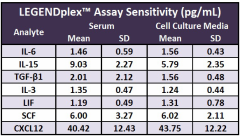- Regulatory Status
- RUO
- Other Names
- IL-6, IL-15, TGF-β1, IL-3, LIF, SCF, CXCL12 (SDF-1)
- Ave. Rating
- Submit a Review
- Product Citations
- publications

-

Sensitivity is defined as the mean minimum detectable concentration (MDC) established by applying a 5-PL curve-fitting algorithm to assay curves run in serum matrix (n = 6) or cell culture media (n = 12) using the LEGENDplex™ Data Analysis Software. -

Representative LEGENDplex™ Mouse HSC Lymphoid Panel standard curves. Data were acquired using a dual laser BD FACSCalibur™ flow cytometer. -

Murine endothelial (CD31posCD41negCD45neg) and microglial cells (CD45posCD11bposF4/80pos) were isolated from digested E10.5 embryonic head tissue via FACS. Cells were co-cultured with OP9-DL1 cells for 7 days, and then culture supernatants were quantified using the LEGENDplex™ Mouse HSC Panel.
Results are presented as the mean target concentration + SD (n = 6 embryos). Data were provided courtesy of Dr. Zhuan Li, MRC Centre for Inflammation Research, University of Edinburgh.
The LEGENDplex™ Mouse HSC Lymphoid Panel (7-plex) is a bead-based multiplex assay panel, using fluorescence-encoded beads suitable for use on various flow cytometers. It allows for simultaneous quantification of 7 key targets involved in hematopoietic stem cell differentiation and lineage specific markers, including IL-6, IL-15, TGF-β1, IL-3, LIF, SCF, and CXCL12 (SDF-1). This assay panel provides higher detection sensitivity and broader dynamic range than traditional ELISA methods. The panel has been validated for use on cell culture supernatant, serum, and plasma samples.
The Mouse HSC Panel is designed to allow flexible customization within the panel. It can also be divided into sub-panels based on target type, listed below:
LEGENDplex™ Mouse HSC Panel (13-plex)
LEGENDplex™ Mouse HSC Lymphoid Panel (7-plex)
LEGENDplex™ Mouse HSC Erythroid Panel (7-plex)
LEGENDplex™ Mouse HSC Myeloid Panel (7-plex)
Kit Contents
- Kit Contents
-
- Setup Beads: PE Beads
- Setup Beads: Raw Beads
- Capture Beads
- Detection Antibody
- Standard Cocktail, Lyophilized
- SA-PE
- Matrix A1, Lyophilized
- Assay Buffer
- Wash Buffer
- Filter Plate
- Plate Sealers
- Lyophilized Standard Reconstitution Buffer
Please note: Lots manufactured before June 2022 include “Matrix A”. There is no change in the protocol. Simply use the Matrix A reagent you received as suggested in the current manual.
Product Details
- Verified Reactivity
- Mouse
- Application
-
Multiplex
Learn more about LEGENDplex™ at biolegend.com/legendplex
Download the LEGENDplex™ software here. - Materials Not Included
-
- Flow Cytometer
- Pipettes and Tips
- Reagent Reservoirs for Multichannel Pipettes
- Polypropylene Microfuge Tubes
- Vortex Mixer
- Sonicator
- Aluminum Foil
- Absorbent Pads
- Plate Shaker
- Centrifuges
- Vacuum Filtration Unit and a Vacuum Source (if using filter plates)
- Manual
Antigen Details
- Biology Area
- Angiogenesis, Cell Biology, Immunology, Signal Transduction, Stem Cells
- Molecular Family
- Cytokines/Chemokines, Growth Factors
- Gene ID
- 16193 View all products for this Gene ID 16168 View all products for this Gene ID 21803 View all products for this Gene ID 16187 View all products for this Gene ID 16878 View all products for this Gene ID 17311 View all products for this Gene ID 20315 View all products for this Gene ID
Related FAQs
- If I don't have a vacuum, how do I remove the liquid from my plate?
-
If you do not have a vacuum, the assay should be run in a V-bottom plate. After centrifugation using a swinging-bucket rotor with a plate adaptor, you can remove the liquid by flicking the plate quickly, dumping the contents into a sink, and patting it dry carefully on a stack of clean paper towels without losing the beads. Alternatively, you can remove the liquid by using a pipette.
- Should I perform the assay with the filter plates or with V-bottom plates?
-
Filter plates or V-bottom plates have been included in some kits for your convenience. A vacuum filtration unit is required to work with the filter plates. However, if you don’t have access to a vacuum manifold or if you prefer, then you can use the V-bottom plates and follow the recommended assay protocols for the type of plates you choose. All plates should be made from low binding polypropylene. Polystyrene ELISA or cell culture plates should not be used.
- After I finish the staining process, how long can I wait before reading my LEGENDplex™ samples?
-
The samples can be kept overnight at 4°C while being protected from exposure to light and be read the next day. There may be a decrease in signal, but overall, the assay results should not be affected. Storing the samples for extended periods of time is not recommended, as it could lead to further reductions in signal.
- What is the shelf life of LEGENDplex™ kits?
-
LEGENDplex™ kits are guaranteed for 6 months from the date of receipt, but may have a shelf life of up to 2 years from the date of manufacture.
- Is special software required for data analysis?
-
Typically flow cytometers generate output files in FCS format (e.g. FCS 2.0, 3.0, or 3.1) and in some cases in list mode file format (LMD). Other software may be available to analyze FCS files. Data generated using LEGENDplex™ kits can be analyzed using the freely available LEGENDplex™ data analysis software. Please check our website for the most updated versions of the software.
 Login / Register
Login / Register 








Follow Us